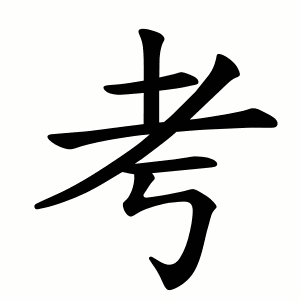考
- to think, to consider, to reflect;
Etymology
It is derived from 老 (ro, “old”).
In oracle bone script (甲骨文 jiǎgǔwén), 考 and 老 shared the same form.
In bronze inscriptions (金文 jinwen), the component 丂 (ko, phonetic) was added, distinguishing 考 from 老.
In the Shuowen Jiezi (説文解字 shuōwén jiězì), the two characters are explained with reference to each other, showing that originally both meant “old, aged.”
Later, 考 developed the derived sense “to think deeply, like an elder.” Over time, its original meaning (“old”) disappeared, while the derived sense extended into new meanings:
“to think, to consider” - “to test, to examine, to investigate.”
Additionally, in Old Chinese 考 also carried the sense “to knock, to strike.” This is connected with the character 攷 (고, to examine, to test), which originally meant “to knock.” 考 and 攷 were used interchangeably.
Usage in Korean
Common compounds:
고려 (考慮) – consideration, deliberation
고사 (考査) – test, exam
참고 (參考) – reference
상고 (上考 / 商考) – ancient examination, or investigation
Words that derived from 考
- 十大卜尸 (JKYS)
- ⿱ 耂 丂 (G T V)
- ⿱ 耂 ⿺ ㇉ 一 (H)
- ⿱ 耂 ⿺ ㇉ 丿 (J K)
